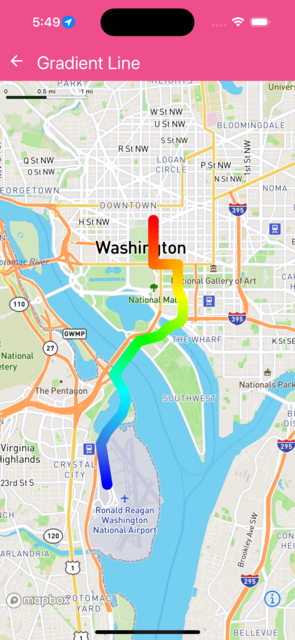Gradient Line
This example demonstrates how to use interpolate expression in the lineGradient property of a LineLayer to create a gradient line.
import React from 'react';
import { MapView, Camera, ShapeSource, LineLayer } from '@rnmapbox/maps';
const styles = {
matchParent: {
flex: 1,
},
lineLayer: {
lineColor: 'red',
lineCap: 'round',
lineJoin: 'round',
lineWidth: 14,
lineGradient: [
'interpolate',
['linear'],
['line-progress'],
0,
'blue',
0.1,
'royalblue',
0.3,
'cyan',
0.5,
'lime',
0.7,
'yellow',
1,
'red',
],
},
};
const lineString = {
type: 'Feature',
geometry: {
type: 'LineString',
coordinates: [
[-77.044211, 38.852924],
[-77.045659, 38.860158],
[-77.044232, 38.862326],
[-77.040879, 38.865454],
[-77.039936, 38.867698],
[-77.040338, 38.86943],
[-77.04264, 38.872528],
[-77.03696, 38.878424],
[-77.032309, 38.87937],
[-77.030056, 38.880945],
[-77.027645, 38.881779],
[-77.026946, 38.882645],
[-77.026942, 38.885502],
[-77.028054, 38.887449],
[-77.02806, 38.892088],
[-77.03364, 38.892108],
[-77.033643, 38.899926],
],
},
};
class GradientLine extends React.Component {
render() {
return (
<>
<MapView style={styles.matchParent}>
<Camera
defaultSettings={{
centerCoordinate: [-77.035, 38.875],
zoomLevel: 12,
}}
/>
<ShapeSource id="line-source" lineMetrics={true} shape={lineString}>
<LineLayer id="line-layer" style={styles.lineLayer} />
</ShapeSource>
</MapView>
</>
);
}
}
export default GradientLine;
 }
}